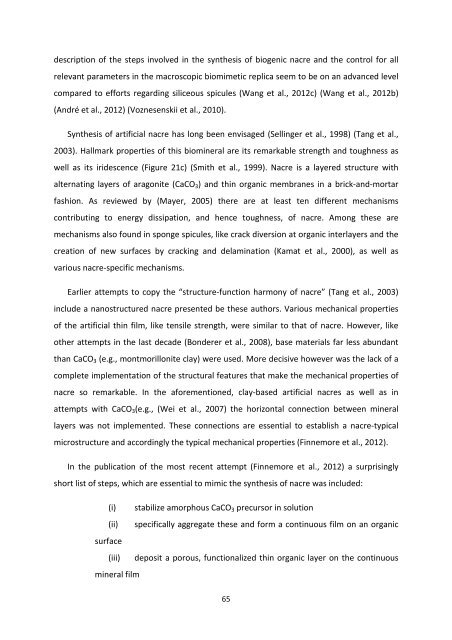MASTER THESIS Biomimetic potential of sponge ... - IAP/TU Wien
MASTER THESIS Biomimetic potential of sponge ... - IAP/TU Wien
MASTER THESIS Biomimetic potential of sponge ... - IAP/TU Wien
You also want an ePaper? Increase the reach of your titles
YUMPU automatically turns print PDFs into web optimized ePapers that Google loves.
description <strong>of</strong> the steps involved in the synthesis <strong>of</strong> biogenic nacre and the control for all<br />
relevant parameters in the macroscopic biomimetic replica seem to be on an advanced level<br />
compared to efforts regarding siliceous spicules (Wang et al., 2012c) (Wang et al., 2012b)<br />
(André et al., 2012) (Voznesenskii et al., 2010).<br />
Synthesis <strong>of</strong> artificial nacre has long been envisaged (Sellinger et al., 1998) (Tang et al.,<br />
2003). Hallmark properties <strong>of</strong> this biomineral are its remarkable strength and toughness as<br />
well as its iridescence (Figure 21c) (Smith et al., 1999). Nacre is a layered structure with<br />
alternating layers <strong>of</strong> aragonite (CaCO 3 ) and thin organic membranes in a brick-and-mortar<br />
fashion. As reviewed by (Mayer, 2005) there are at least ten different mechanisms<br />
contributing to energy dissipation, and hence toughness, <strong>of</strong> nacre. Among these are<br />
mechanisms also found in <strong>sponge</strong> spicules, like crack diversion at organic interlayers and the<br />
creation <strong>of</strong> new surfaces by cracking and delamination (Kamat et al., 2000), as well as<br />
various nacre-specific mechanisms.<br />
Earlier attempts to copy the “structure-function harmony <strong>of</strong> nacre” (Tang et al., 2003)<br />
include a nanostructured nacre presented be these authors. Various mechanical properties<br />
<strong>of</strong> the artificial thin film, like tensile strength, were similar to that <strong>of</strong> nacre. However, like<br />
other attempts in the last decade (Bonderer et al., 2008), base materials far less abundant<br />
than CaCO 3 (e.g., montmorillonite clay) were used. More decisive however was the lack <strong>of</strong> a<br />
complete implementation <strong>of</strong> the structural features that make the mechanical properties <strong>of</strong><br />
nacre so remarkable. In the aforementioned, clay-based artificial nacres as well as in<br />
attempts with CaCO 3 (e.g., (Wei et al., 2007) the horizontal connection between mineral<br />
layers was not implemented. These connections are essential to establish a nacre-typical<br />
microstructure and accordingly the typical mechanical properties (Finnemore et al., 2012).<br />
In the publication <strong>of</strong> the most recent attempt (Finnemore et al., 2012) a surprisingly<br />
short list <strong>of</strong> steps, which are essential to mimic the synthesis <strong>of</strong> nacre was included:<br />
(i) stabilize amorphous CaCO 3 precursor in solution<br />
(ii) specifically aggregate these and form a continuous film on an organic<br />
surface<br />
(iii) deposit a porous, functionalized thin organic layer on the continuous<br />
mineral film<br />
65

















